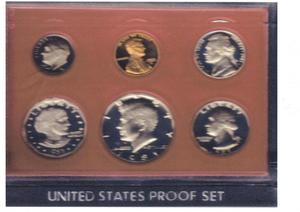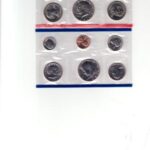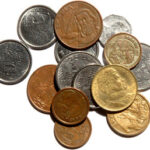I have been collecting coins enthusiastically since 1992 and discovered that one of the most exciting ways to collect coins is through the purchase of proof sets. What is a proof set? Proof sets are small collections of coins, packaged by the mint, which include specially produced versions of coins struck in a given year. Proof coins are those whose planchets (the blank piece of metal upon which a coin is struck) are highly polished and struck multiple times so as to render a coin with magnificent quality in detail. Upon the completion of the minting process, proof coins possess beautiful mirror-like surfaces, magnificent detail and, in the case of proof coins from the past two or three decades, frosted (cameo) designs. These coins are then carefully placed into a holder (nowadays, the packaging choice is a hard plastic case that can safely house the coin for decades) and sold to the public.
For those who have heard of the term “coin grading” but are unaware of the details, it is important to realize that “proof” is not a grade-it is a method of manufacture. Proof coins are graded by wear just as business strikes are (business sterikes are those produced for circulation). As the occasional proof coin is found in circulation (probably spent by the unwitting young child who dipped into his or her parents’ coin collection to buy a candy bar?), you may come across in your coin-purchasing travels a coin graded as Proof-50 or Proof 45 (for instance), which could be translated into the business-strike-respective grades of About Uncirculated-50 (AU 50) or Choice Extremely Fine-45 (Ch. XF 45).
The United States Mint began making proof coins and proof sets on a sporadic basis in the 19th century. However, the modern era of proof set production began in 1936, when sets started to be made on an annual basis, with some exceptions. The first such proof set cost $1.89 when it was first sold to the public and, when it was first released, contained the Lincoln cent through Walking Liberty half dollar. Proof coin production ceased in 1942, but was restarted in 1950. Beginning in 1955, the United States Mint began packaging their proof sets in flat cellophane packs, which was a housing improvement over the small cardboard boxes that had been the means of packaging that the mint used. With the cellophane packaging, there were fewer concerns with toning, and the cellophane packaging was a far more convenient way of keeping all the coins stored together. Annual proof set production continued through 1964.
Beginning in 1965, during the time the United States Mint began striking copper-nickel clad coinage (as opposed to silver coinage; the lone exception was the half-dollar which, for five more years, merely saw a reduction in the amount of its silver content), the production of Special Mint Sets began. Special Mint Set coins have a strike and surface that generally looks a bit inferior to those found on proof coins; however, the quality of Special Mint Set coins is quite a bit better than typical business strikes. The 1965 set was packaged in the same sort of cellophane packaging that had been used for proof sets of the previous ten years. In 1966, the mint switched the Special Mint Set packaging format over to a hard plastic case.
In 1968, the United States Mint resumed to making bona fide proof sets. However, two major changes were now in place-proof coins were now being produced at the San Francisco Mint instead of the Philadelphia mint, which had been the location where proof coins were struck up until this point; and the proof set packaging now was a hard plastic case, unlike the cellophane of earlier years and similar to the Special Mint Set packaging of 1966 and 1967. In 1975, the mint began striking a special three-coin proof set that includes 40% silver versions of the Bicentennial quarter, half-dollar, and dollar coins. These proof sets were sold by the mint for a number of years after the original 1975 release.
Proof set production continued on without any great changes until 1983, when the United States Mint began offering Prestige Proof Sets along with the usual offering of regular annual proof sets. Prestige proof sets contain the specimens of the circulating coins plus, for the most part, whatever commemorative half dollar or dollar coin designs were also being struck in a given year. In 1992, the United States Mint began producing Silver Proof Sets and Silver Premier Proof Sets. The main difference between the Silver Proof Sets and Silver Premier Proof Sets comes in the packaging. While the Silver Proof Set comes in the same sort of plastic case used for regular proof sets, the Silver Premier Proof Set is housed in a more refined, aesthetically superior display case. Both silver proof sets contain specimens of the regular, circulating coins. However, the dime, quarter, and half-dollar coins in these silver proof sets are struck with a 90% silver composition. The last Silver Premier Proof Set was released in 1998, but the United States Mint continues to produce regular Silver Proof Sets.
Starting in 1999, the United States Mint began striking Statehood quarters. In conjunction with the new and popular coin program, the mint started to offer proof sets that contained only the Statehood quarters as well as proof sets that combined the Statehood quarters with the other regular-strike coinage. The mint also continued to offer proof sets that contain 90% silver versions of the dime, quarter, and half-dollar coins. In 2004, the United States Mint began production of the Westward Journey nickel program, which called for the release of coin sets that include both proof and uncirculated versions of the two different nickel designs that were being produced in 2004 and 2005. In 2007, the United States Mint started the projected decade-long release of Presidential dollars, which are being sold in four-coin sets that feature each year’s offering of four new designs honoring our deceased presidents, in chronological order beginning with George Washington and, as of this writing, finishing with Gerald Ford in 2016.
As one can see, the history of United States proof sets is long and colorful. Many collectors spend years assembling holdings devoted entirely to the assembly of a complete proof set collection. While current-year proof sets can be purchased directly from the United States Mint, those who would like to purchase proof sets from earlier years can look to coin dealers, many of whom offer extensive offerings of proof sets via the internet, magazine mail-order, and within physical storefronts.



